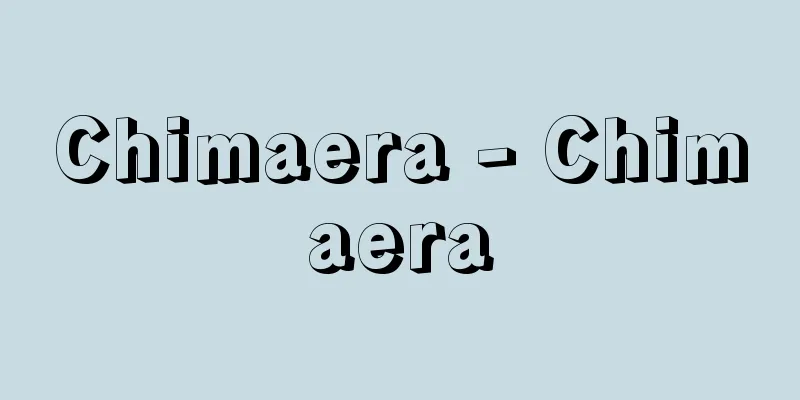Chimaera - Chimaera

|
A general term for a family or genus of the order Chimaeriformes in the subclass Holocephala, or the name of one of its species. Holocephali (chimaeras) are closely related to the order Elasmobranchii (sharks and rays), but they have only one pair of gill slits, which distinguishes them from the Elasmobranchii, which have 5 to 7 pairs of gill slits. In addition to the Chimaeridae, the order Chimaeriformes has three other families: the Rhinochimaeridae and the Callorhinchidae. Of these, the Callorhinchidae are found only in the Southern Hemisphere, but the other two families are found widely throughout the world. Chimaeridae are fertilized internally and lay eggs in elongated eggshells. The male has a pair of copulatory organs on the inner edge of his pelvic fin, with the tips being bifurcated or trifurcated. In addition, the male has special protrusions with spines just before his pelvic fin and on his forehead, which he uses to hold down the female during mating. The Chimaera family (English name: shortnose chimaeras) is characterized by a rounded snout (the tip of the nose) and the lack of a sword-shaped or horseshoe-shaped protrusion. The Chimaera family is further divided into the Chimaera genus, which has an anal fin, and the Hydrolagus genus, which does not. There are three species of the Chimaera genus and five species of the Hydrolagus genus in the waters near Japan, but a taxonomic reexamination is needed. The name of the genus Chimaera comes from the Greek mythological monster Chimera, which has a lion's head, a goat's body, a snake's tail, and breathes fire from its mouth. This species of chimaera was named after the monster because of its unique appearance, but it is calm and mainly lives near the bottom of the ocean in the deep sea (sometimes more than 2000 meters). Its pectoral fins are very large, and it swims slowly by flapping its wings like a bird. The species of chimaera, C. phantasma (English name: silver chimaera), is the most common species of chimaera fish found in the waters off Japan. It has a silver body color and a regularly wavy lateral line on the front of its body. It lives at depths of 20 to 960 meters. It reproduces by oviposition. It mates in spring, when the male wraps his body around the female and holds her down with the front of his pelvic fins and the protrusions on his forehead. The eggshell is yellowish brown and oblong, with a long diameter of about 160 to 270 mm. It is found in the Pacific Ocean south of Hokkaido, the East China Sea, and the South China Sea, and occasionally in the Sea of Japan. It is caught by trawling and is used as an ingredient in fish paste products. The species name phantasma means "something shaped like" and the scientific name given to it means "fish shaped like a fire-breathing monster." The International Union for Conservation of Nature (IUCN) Red List lists it as "vulnerable" (VU), a category of threatened species (as of August 2021). [Kazuhiro Nakatani September 17, 2021] [References] | | | | |© Tadaaki Ohkata "> Chimaeridae (specimen drawing) Source: Shogakukan Encyclopedia Nipponica About Encyclopedia Nipponica Information | Legend |
|
軟骨魚綱全頭(ぜんとう)亜綱ギンザメ目の科や属の総称、またはその1種の名称。全頭類(ギンザメ類)Holocephali(英名chimaeras)は板鰓(ばんさい)類(サメ・エイ類)Elasmobranchiiと近縁であるが、鰓孔(さいこう)が1対(つい)しかないことで、鰓孔が5~7対ある板鰓類と区別できる。ギンザメ目Chimaeriformesには、ギンザメ科Chimaeridaeのほかに、テングギンザメ科Rhinochimaeridaeとゾウギンザメ科Callorhinchidaeの計3科がある。このうち、ゾウギンザメ科は南半球にのみ分布するが、ほかの2科は全世界に広く分布する。ギンザメ類は体内受精で、細長い卵殻に入った卵を産む。雄の腹びれ内縁には交尾器が1対あり、その先端が二叉(にさ)または三叉している。雄はさらに腹びれ直前と前頭部に棘(とげ)の生えた特殊な突起をもち、交尾のときこれらを用いて雌を押さえる。 ギンザメ科(英名shortnose chimaeras)は吻(ふん)(鼻先)が丸く、剣状や馬蹄(ばてい)形の突起がないことが特徴である。さらにギンザメ科は臀(しり)びれのあるギンザメ属Chimaeraと、臀びれのないアカギンザメ属Hydrolagusに分類される。日本近海にはギンザメ属に3種、アカギンザメ属に5種が認められているが、分類学的に再検討をする必要がある。 ギンザメ属のキマエラChimaeraという属名は、ギリシア神話のライオンの頭、ヤギの体、ヘビの尾をもち、口から火を吐く怪獣キメラChimera(キマイラ)に由来する。このギンザメ類はその独特の姿かたちから怪獣の名をつけられたが、行動は穏やかで、おもに深海(ときに2000メートルを超える)の海底付近に生息する。胸びれは非常に大きく、この胸びれで鳥のように羽ばたき運動をし、ゆっくりと泳ぐ。 種としてのギンザメC. phantasma(英名silver chimaera)は、日本近海産のギンザメ科魚類のなかで、もっとも普通にみられる種類であり、体色が銀色で、体の前部の側線が規則的に波状になっていることなどの特徴をもつ。生息水深は20~960メートルである。生殖方法は卵生。交尾期は春で、雄は雌の体に体を巻き付け、腹びれ前部や前頭部の突起で雌を押さえて交尾する。卵殻は黄褐色、長楕円(ちょうだえん)形で、その長径は160~270ミリメートルくらいである。北海道以南の太平洋、東シナ海、南シナ海などに分布し、まれに日本海でもとれる。トロール網などで漁獲され、練り製品の原料などとなる。種名ファンタスマphantasmaは「~の形したもの」の意で、「火吹き怪獣の形をした魚」の意味の学名が与えられている。国際自然保護連合(IUCN)のレッド・リストでは、絶滅危惧(きぐ)種中の「危急」(VU)に指定されている(2021年8月時点)。 [仲谷一宏 2021年9月17日] [参照項目] | | | | |©大片忠明"> ギンザメ〔標本画〕 出典 小学館 日本大百科全書(ニッポニカ)日本大百科全書(ニッポニカ)について 情報 | 凡例 |
>>: Ginza Haccho - Ginza Haccho
Recommend
Prefabricated building - Prehabukenchiku (English spelling) prefabricated building
In a broad sense, it is a general term for buildi...
Sunpuki - Sunpuki
A record of the early Edo period. One volume. Als...
Ichigaya Prison
...It is within the former Ushigome Ward, and in ...
Standards for manufacturing and quality control of pharmaceuticals
...Therefore, when formulating drugs, efforts are...
Null hypothesis
A statistical hypothesis that one variable is unre...
The Awakening of Faith in the Mahāyāna - Daijō Kishinron
A Buddhist treatise. One volume. It is also calle...
Henry Mayhew
1812‐87 British journalist. In 1841, he became the...
Emperor Kokutoku
Year of death: Hakuchi 5.10.10 (654.11.24) Year of...
The first festival of the sacred garment weaving ceremony
...The main purpose of this festival is to exchan...
Diesel car
Also called diesel railcars. A diesel railcar is a...
Kinri goryo (forbidden treasure)
In the early Edo period, Tokugawa Ieyasu reorganiz...
Algebraic function
An n -th degree equation in y with coefficients P ...
Kisaburo Onogawa
Year of death: Bunka 3.3.12 (1806.4.30) Year of bi...
Phlipponneau, M. PhlipponneauM
...To that extent, the applied branch of systemat...
Hakuwa
Colloquial Chinese. It is contrasted with written...









